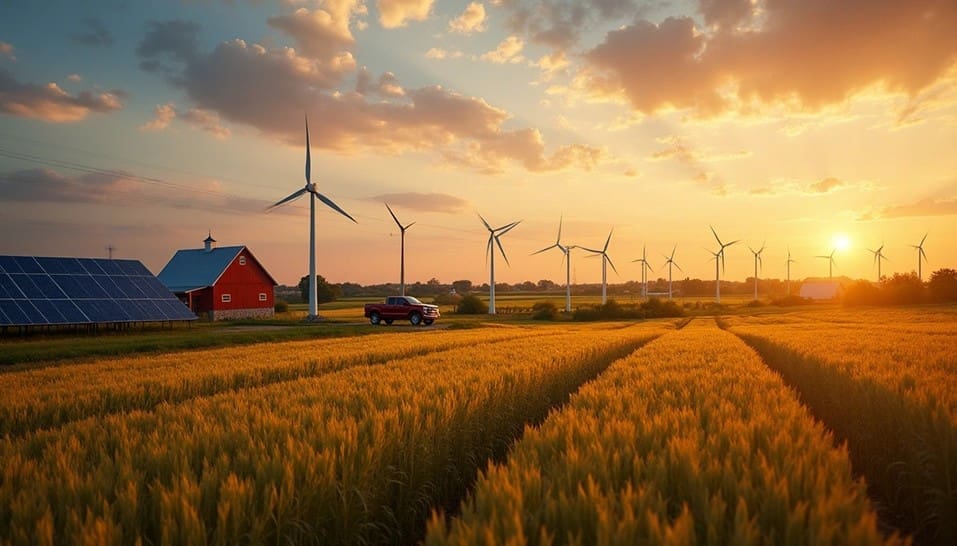Renewable energy policies are turning rural America into multi-million-dollar economic powerhouses. Electric cooperatives serve 13% of the US electricity load and lead this rural energy transformation. These cooperatives include 832 distribution co-ops and 63 generation and transmission co-ops that power most of rural America, including over 90% of the country’s persistent poverty counties.
A complete renewable energy policy creates new opportunities for economic growth in these regions. Clean energy policy could bring $4.8 billion to Arkansas and $4.2 billion to North Dakota through new wind and solar projects. The retirement of Ohio’s 1,265 MW Cardinal coal plant could generate nearly $2 billion through over 4,000 MW of wind and solar development. Florida’s numbers look promising too. The Seminole coal plant could lead to 4,400 MW of solar projects that would pump $2.3 billion into rural communities.
The numbers tell a compelling story. A $10 billion investment to support co-ops’ green energy policy implementation could generate over $50 billion in economic development. These energy initiatives create high-skilled, well-paying jobs and reduce energy costs for residents and businesses. Farmers receive steady income through land leases for renewable projects. European Commission estimates suggest that by 2030, citizen-led energy communities could own up to 17% of wind and 21% of solar power. This shows a growing trend in community-driven solutions.
This piece explores how renewable energy policies will build $100 million rural economies in 2025. We look at federal initiatives, economic models, and the vital transition from coal to clean energy in cooperative territories.
Federal Renewable Energy Policies Driving Rural Investment
The federal government has released unprecedented financial support to develop rural renewable energy through targeted policies and programs. Rural communities that were once overlooked are now becoming economic powerhouses in 2025, thanks to these initiatives.
The Inflation Reduction Act serves as the lifeblood of these efforts with historic provisions designed for rural communities. The USDA’s Empowering Rural America (New ERA) program has allocated $9.7 billion in grants and loans. Electric cooperatives can use these funds to purchase or build new clean energy systems. The program gives co-ops the flexibility to invest in renewable energy, storage, and transmission efficiency improvements based on their specific needs.
The Powering Affordable Clean Energy (PACE) program offers $1 billion in partially forgivable loans to renewable energy developers and electric service providers. The USDA has put more than $1.6 billion in PACE program funds to work on clean energy projects that serve rural Americans.
Rural cooperatives have seen a significant change through the direct-pay tax credit provision. A co-op CEO put it simply: “Without direct-pay, investment in rural America was being stifled”. Tax-exempt co-ops can now receive payments equivalent to tax credits for clean energy projects, putting them on par with investor-owned utilities.
The economic effects are significant. The USDA announced clean energy investments exceeding $6 billion through these programs. Rural electric cooperatives have pledged to build or purchase more than 13 gigawatts of clean energy. The USDA has awarded about $14.5 billion in grants and loans that benefit 35 states.
These policies fund various projects:
- Solar, wind, and battery storage systems
- Community solar projects serving neighborhood families
- Electric vehicle charging infrastructure
- Biofuel-related infrastructure
These investments stimulate job creation, reduce energy costs, and make the grid more resilient in rural areas. The scale of federal support shows a steadfast dedication to rural communities. They are not just keeping pace with the clean energy transition but becoming centers of economic growth through renewable energy development.
Economic Modeling of $100M Rural Growth Scenarios
Renewable energy investments are bringing significant economic value to rural communities. These communities can now reach $100 million in local economic activity. Different revenue streams work together to build thriving rural economies.
Farmers and ranchers who host wind turbines get substantial land lease payments. These payments are the lifeblood of economic change in rural areas. Wind farms pay out $245 million annually to these landowners. States like Iowa, Illinois, and Kansas see landowners receiving $10 million annually from wind leases. Solar development brings even better returns. Farmers can earn $1,000 per acre, which is much higher than the national average of $146 for non-irrigated cropland.
Property tax growth plays a vital role in this development. The small town of Colfax, Illinois, with just 1,000 residents, saw its property tax base jump from $61 million in 2006 to $102 million in 2008. Local schools used this money for new projects and stayed strong during tough economic times. Renewable projects now generate $1.7 billion annually in various taxes nationwide.
New jobs complete this economic success story. Wind projects of 100 megawatt size create 80-100 jobs during construction. These projects need 2-16 full-time workers to operate and maintain them over their 30+ year lifespan. Local businesses like hotels, restaurants, and services also see more customers during construction.
Investment capital powers these economic benefits. Iowa has attracted $25 billion in renewable energy investments. Michigan follows with $8 billion. The United States’ total stands at an impressive $499 billion in renewable energy investments.
Rural electric cooperatives now lead the way in renewable energy adoption. Kalona’s Farmers Electric Cooperative generates 15 percent of its power from solar. This shows how local energy control keeps economic benefits within rural communities.
Transitioning from Coal to Clean Energy in Co-op Territories
Rural American electric cooperatives are beginning a historic change from coal-fired power plants to renewable energy systems. These co-ops heavily depend on coal, and their customers just need to deal with high energy bills and major health and environmental effects. All the same, 2025 will be a crucial year as electric generators plan to retire 12.3 gigawatts of capacity. This represents a 65% increase in retirements compared with 2024, and coal makes up 66% of planned retirements.
The Biden Administration’s USDA programs have sped up this switch through strategic collaborations. Rural Colorado co-ops received a combined $800 million in New ERA and PACE funding, making Colorado the state with the most recipients. The Tri-State Generation and Transmission Association got $679 million to retire coal units in three states and purchase 1,480 megawatts of wind, solar, and battery storage.
Battery Energy Storage Systems (BESS) now serve as the technological foundation of this transition. These systems improve energy resilience by storing excess energy and releasing it when people just need it most. This reduces rural areas’ dependence on diesel generators. Of course, these systems work well—the Hornsdale Power Reserve in South Australia has handled grid instability in milliseconds since 2017, which saved millions in stabilization costs.
Ohio’s Buckeye Power shows this transition through its Cardinal coal plant. The company spent $1 billion on environmental controls over 20 years, but now plans to shut down Cardinal Unit 3 by 2028’s end. Xcel Energy will also close Comanche 2 in Colorado and convert its 505MW Pawnee unit from coal to gas.
Progress continues, but challenges exist. Co-ops serve 92% of counties with persistent poverty, where low-income households pay up to three times more than their higher-income neighbors for energy. Clean energy transitions aim to create affordable, reliable power systems that boost economic growth in America’s struggling rural communities.
Conclusion
Renewable energy policies have turned rural America into economic powerhouses worth $100 million and beyond. This piece shows how federal initiatives, economic modeling, and the shift from coal to clean energy create new opportunities for overlooked communities.
Rural renaissance has electric cooperatives at its vanguard. The Inflation Reduction Act’s $9.7 billion Rural America initiative and the $1 billion PACE program have stimulated this growth. Direct-pay tax credits have leveled the playing field for rural co-ops, which led to 13 gigawatts of clean energy commitments in 35 states.
Economic benefits flow through many channels. Farmers now earn $1,000 per acre from solar installations, compared to $146 from traditional cropland rentals. Wind farms generate $245 million in lease payments nationwide each year. Property tax bases have grown substantially – Colfax, Illinois’s values jumped from $61 million to $102 million after wind development. Each 100-megawatt project brings 80-100 construction jobs plus permanent maintenance positions.
The shift away from coal marks a vital part of rural America’s economic revival. Electric cooperatives serve 92% of persistent poverty counties and now deploy renewable alternatives with battery storage systems faster than ever. We have a long way to go, but we can build on this progress, especially for low-income households that pay higher energy costs.
This change means more than environmental progress – it brings economic justice to rural America. These communities now lead the renewable energy revolution after decades of neglect. Rural economies reaching $100 million by 2025 show what happens when smart policy meets local determination. These soaring wins are the foundations for other communities seeking economic revitalization through renewable energy development.
FAQs
Q1. How are renewable energy policies benefiting rural economies? Renewable energy policies are driving significant economic growth in rural areas through federal investments, land lease payments to farmers, increased tax revenues, and job creation in clean energy sectors.
Q2. What federal programs are supporting rural renewable energy development? Key federal initiatives include the Empowering Rural America (New ERA) program, which provides $9.7 billion in grants and loans, and the Powering Affordable Clean Energy (PACE) program, offering $1 billion in partially forgivable loans for clean energy projects.
Q3. How much can farmers earn from leasing land for renewable energy projects? Farmers can earn over $1,000 per acre annually from solar installations, significantly more than the average $146 per acre for traditional cropland rentals. Wind farms also provide substantial lease payments, totaling $245 million annually nationwide.
Q4. What economic impact do renewable energy projects have on local communities? Renewable energy projects boost local economies by increasing property tax bases, creating jobs during construction and operation phases, and stimulating business activity in sectors like hospitality and local services.
Q5. How are electric cooperatives transitioning from coal to clean energy? Electric cooperatives are retiring coal plants and investing in renewable energy sources and battery storage systems. This transition is supported by federal funding and aims to provide more affordable and reliable power to rural communities while promoting economic revitalization.






